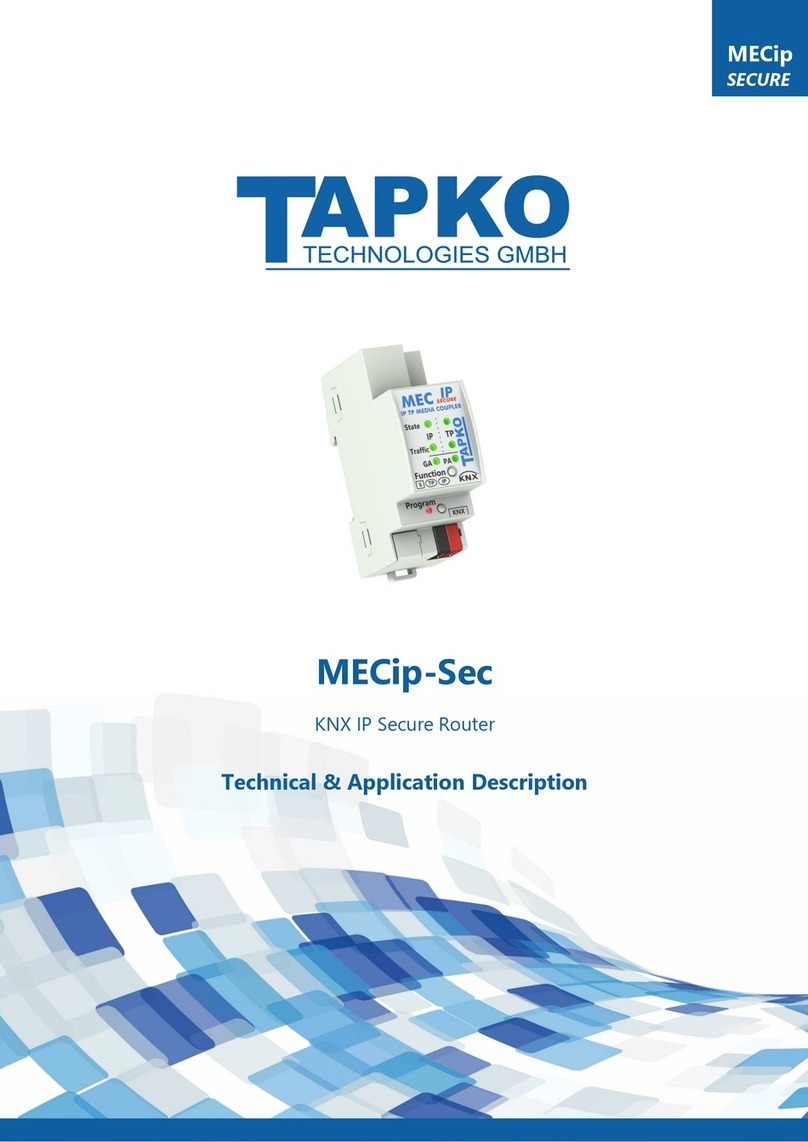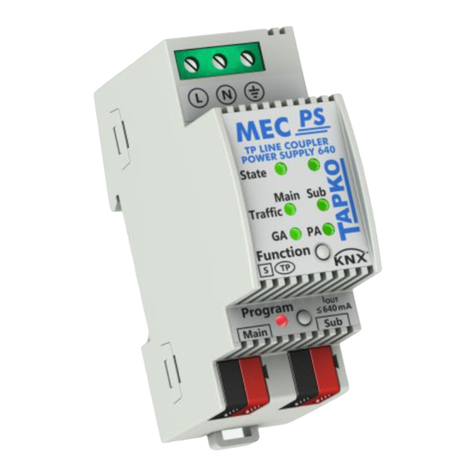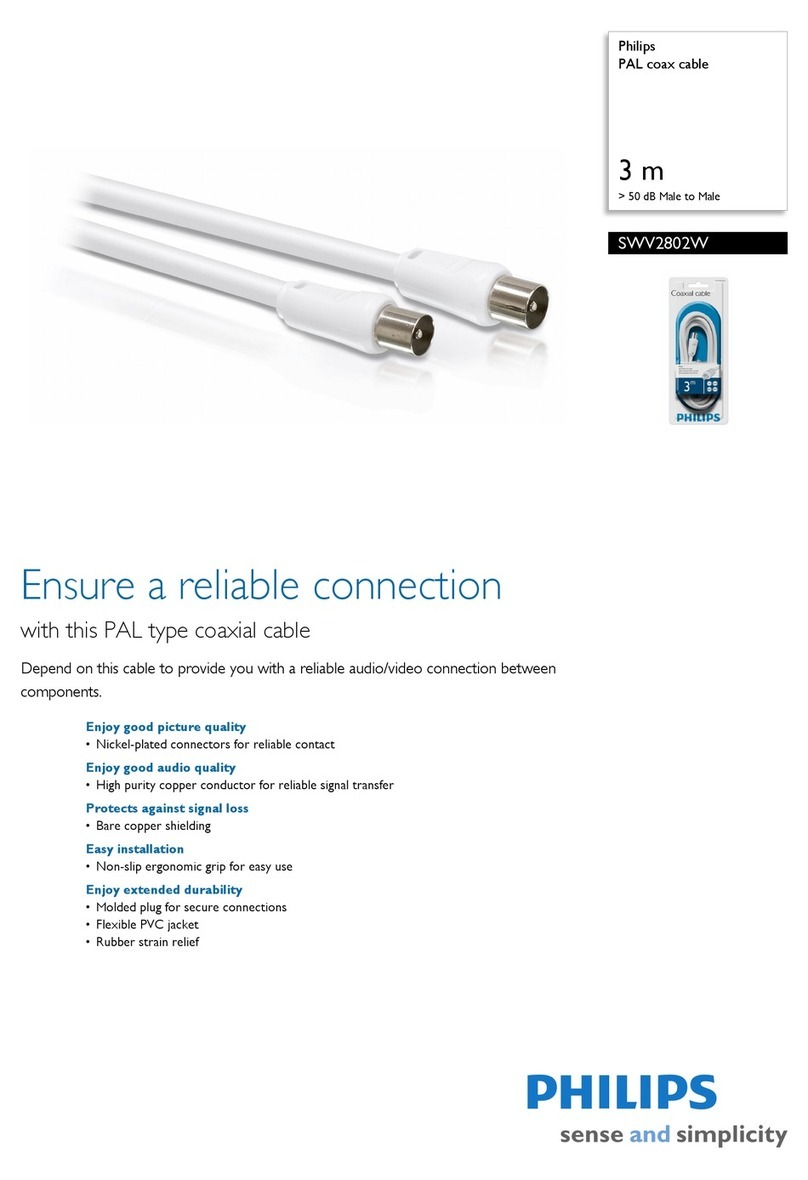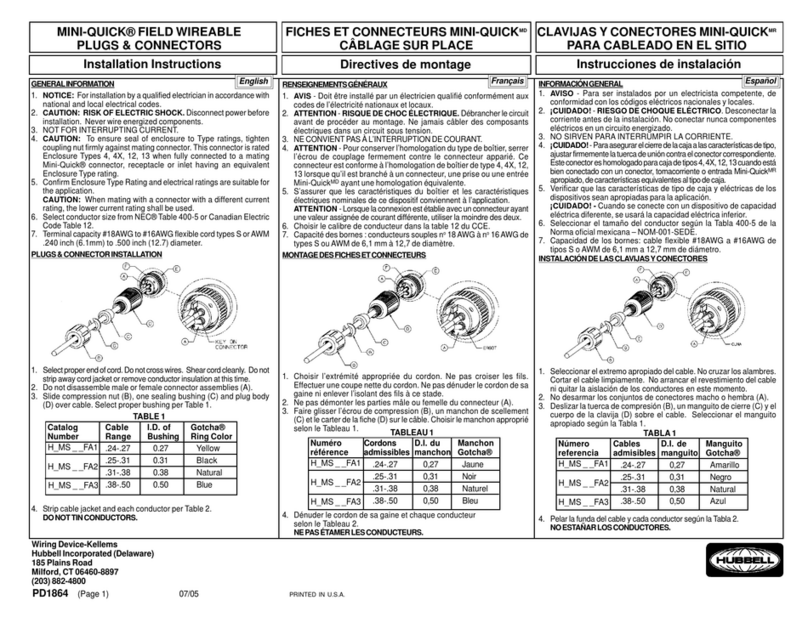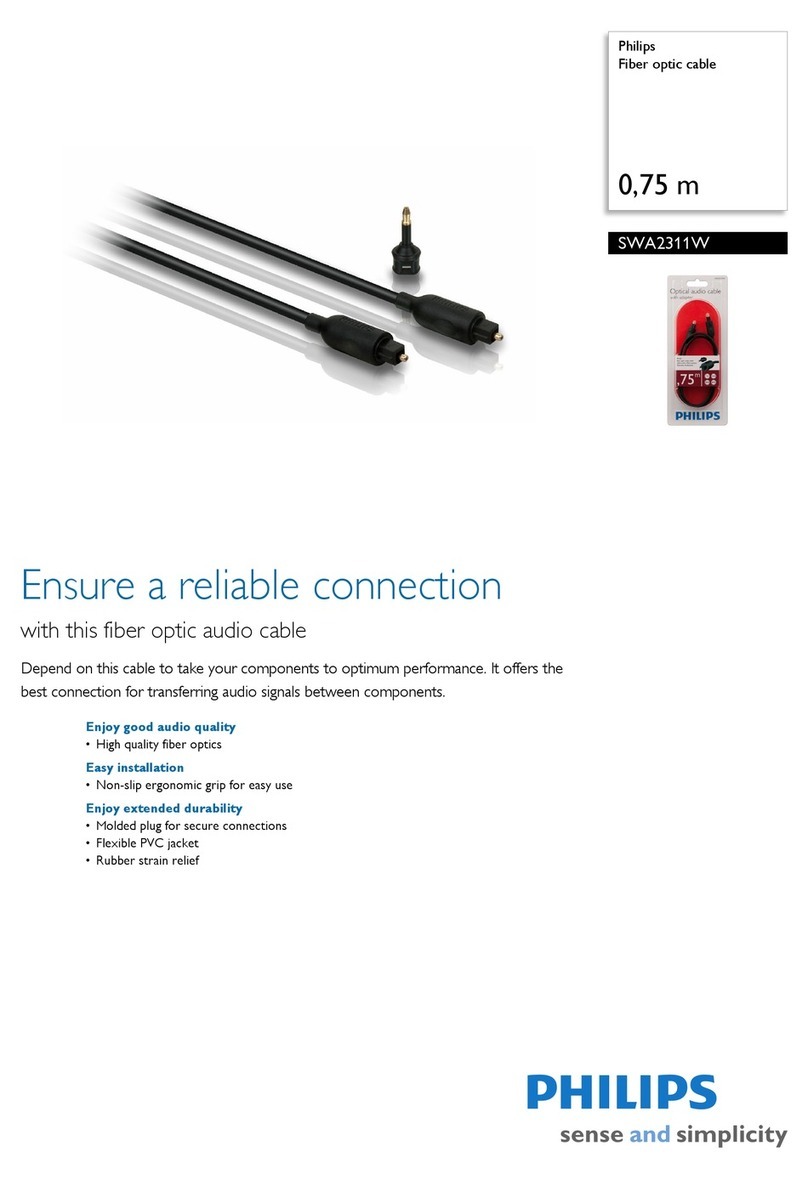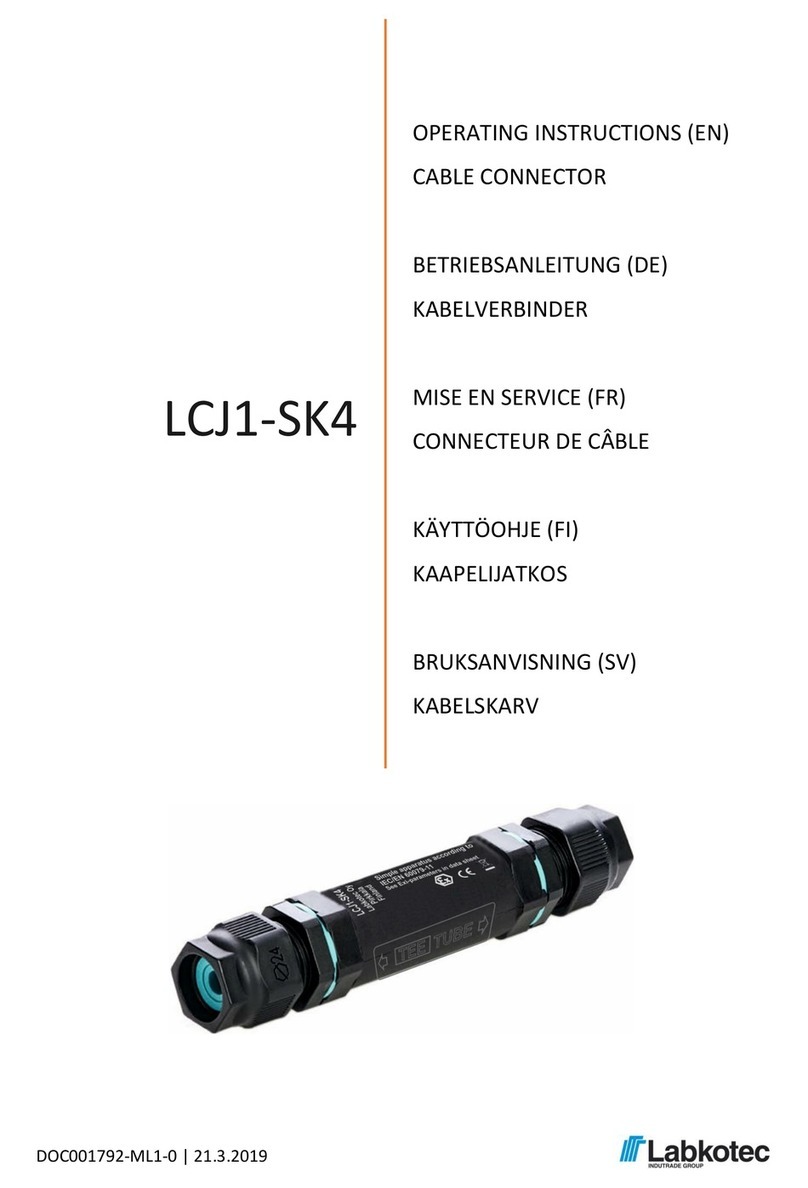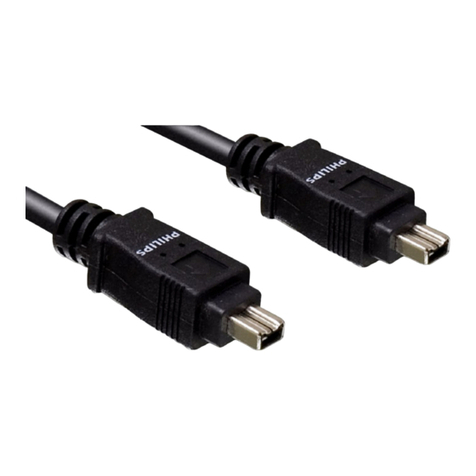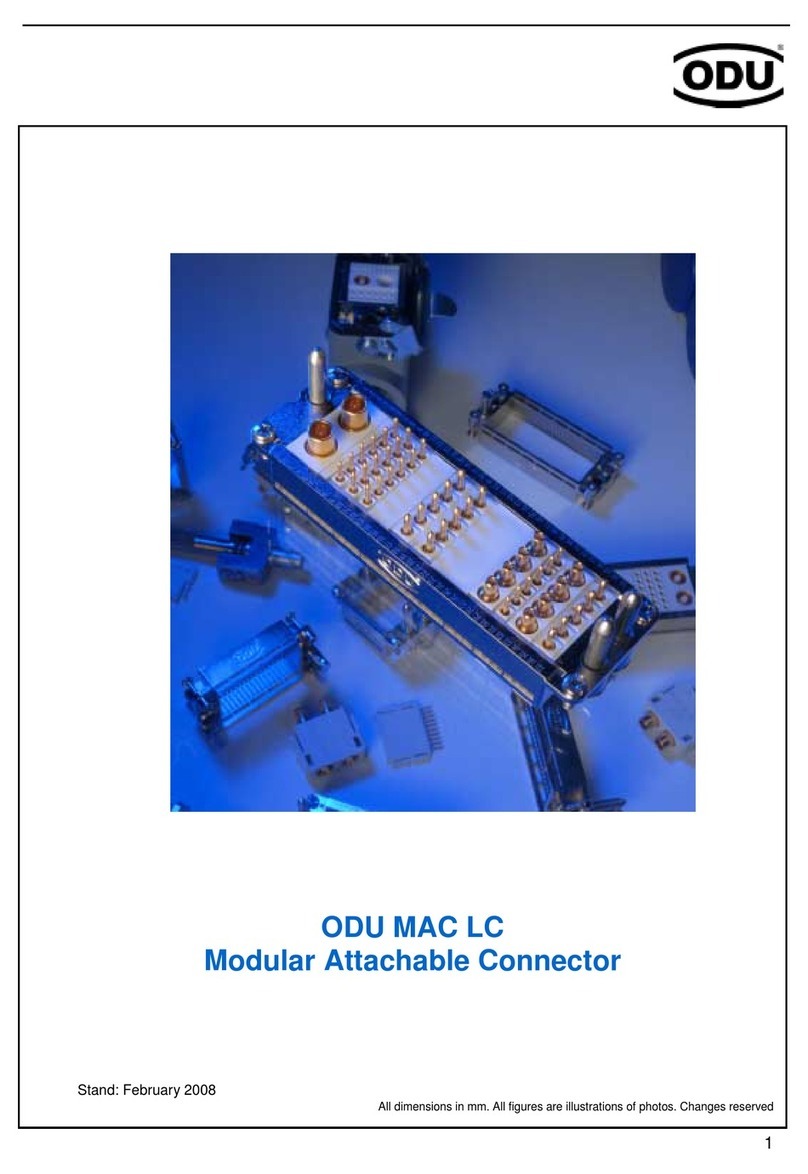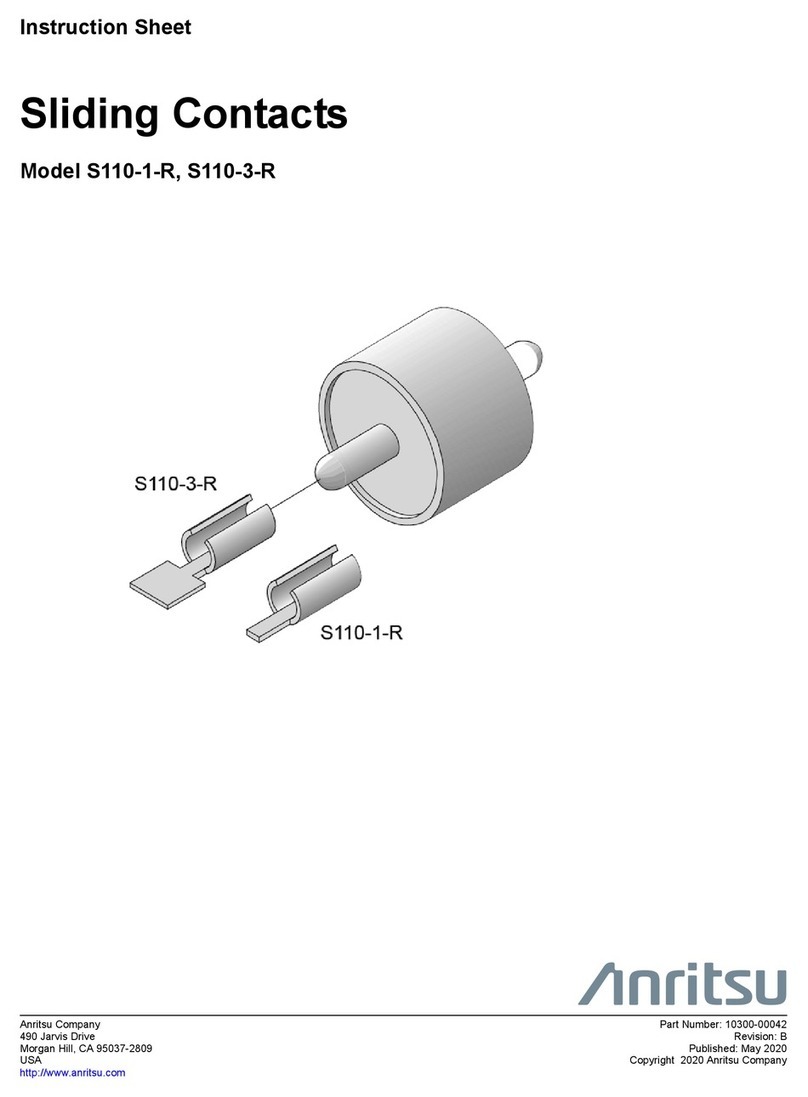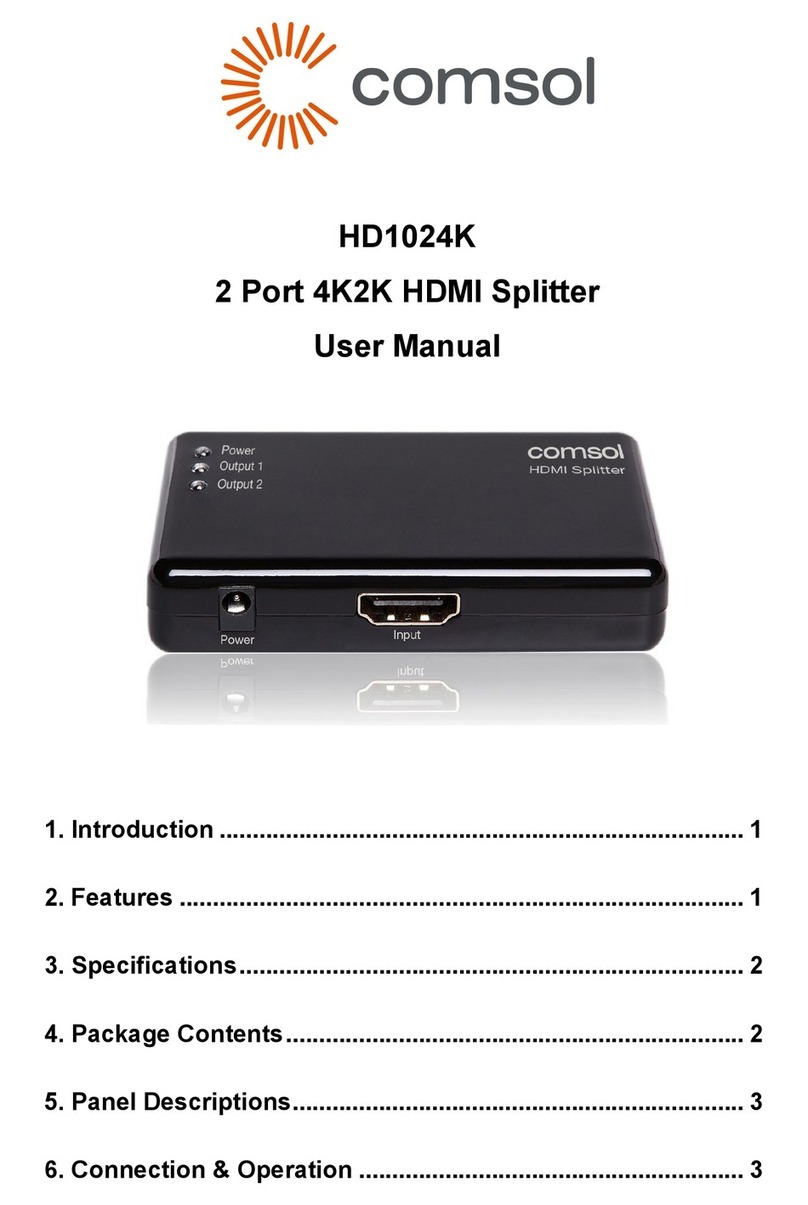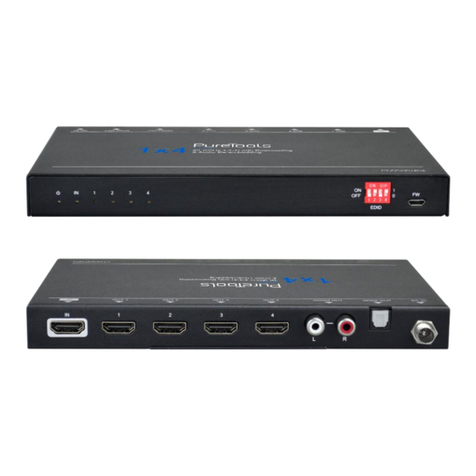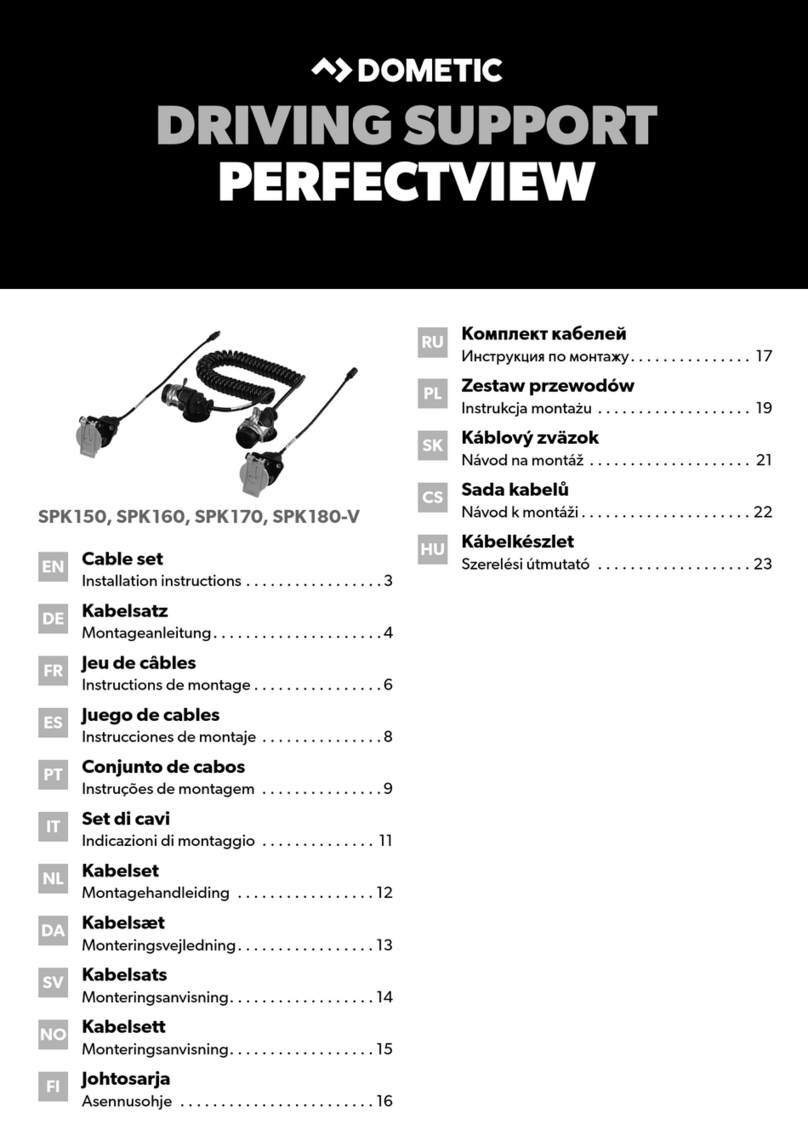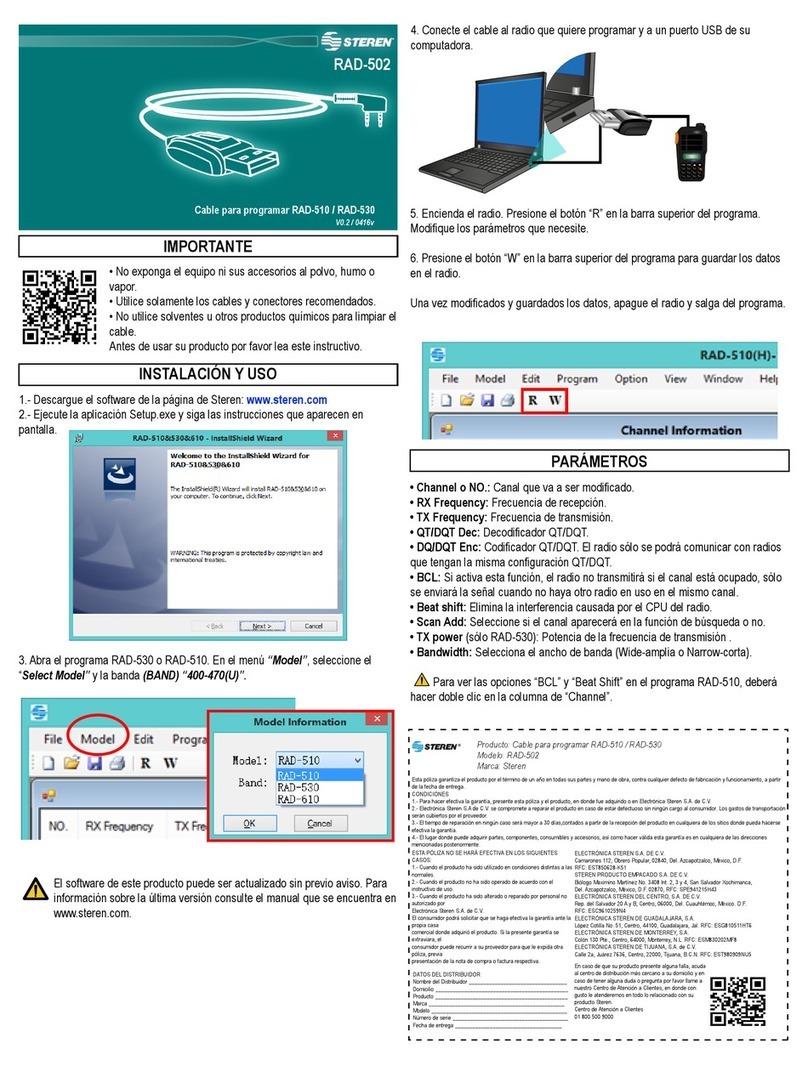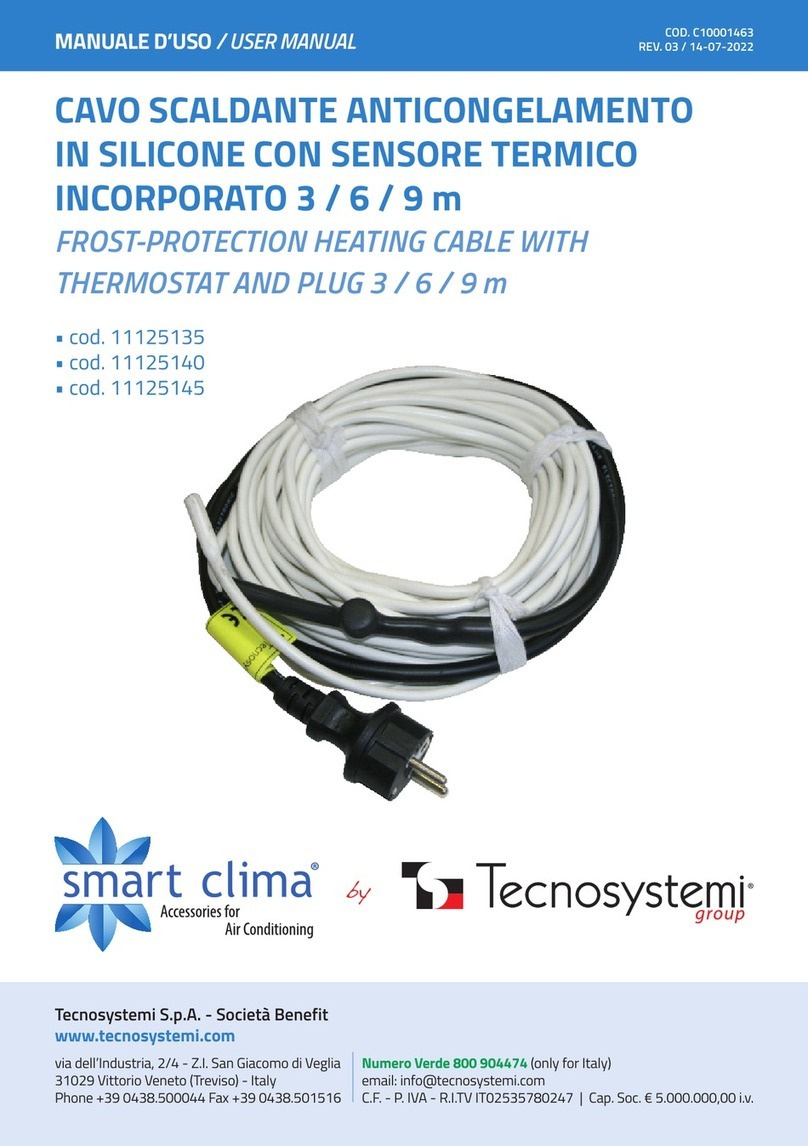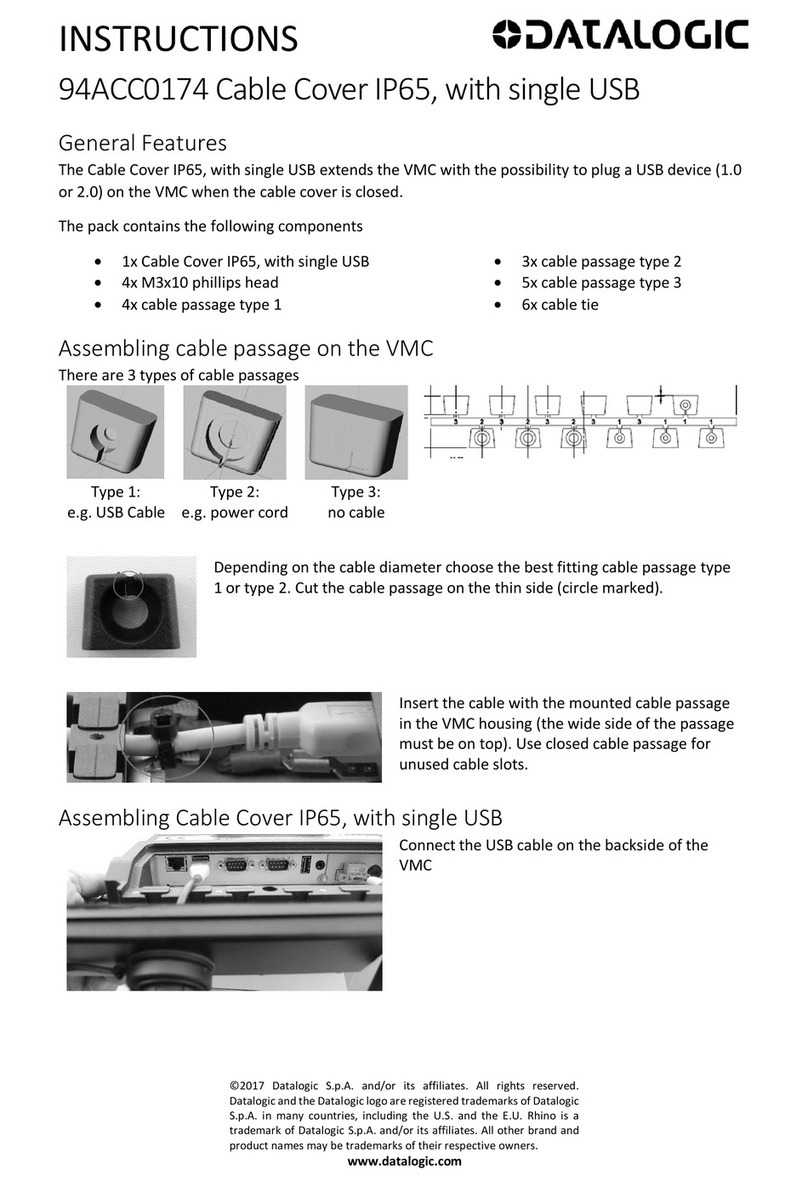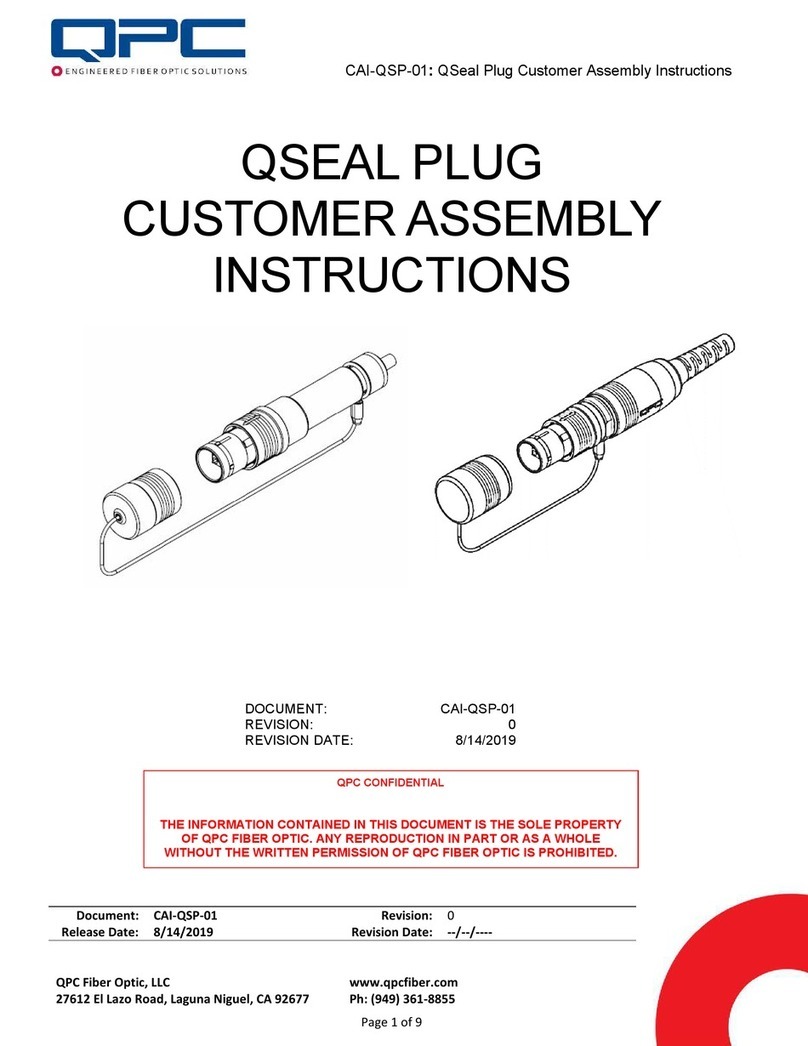TAPKO MECrf User manual

Operating Instructions
MECrf
Release version/date: R1.6 / December 2020
© 2001-2020 TAPKO Technologies GmbH
Im Gewerbepark A15, 93059 Regensburg, Germany
Details, modifications and corrections may be subject to change without notice. TAPKO gives no warranty for the accuracy of the document. All rights reserved.
Product description
Connectors, buttons and LEDs description
The TP RF media coupler MECrf is a KNX RF Ready S-mode (RF1.R) router for
connecting KNX RF line and KNX TP line, or more exact, for connecting KNX RF
devices to the TP installation. MECrf can establish direct connections to RF
devices, and can also be used as a retransmitter. Operational and filtering
states, malfunction and faulty communication are indicated by LEDs.
MECrf is able to filter the traffic according to the installation place in the bus
system hierarchy and according to the built-in filter tables for group-oriented
communication. Long messages with up to 201 bytes APDU are supported.
Configuring from subline can be deactivated. Special functions for transmission
of telegrams are available. Filtering can be temporarily deactivated on pressing
the Function button (Manual Function), i.e. to ease commissioning. It can be
activated by a single button press on the device. MECrf then automatically
switches back to normal operation after a configurable time period.
Requirements of Directives RED and RoHS are met. Standards for residential,
commercial, and industrial environments are fulfilled.
Hereby, TAPKO Technologies GmbH declares that the radio equipment type
MECrf is in compliance with Directive 2014/53/EU.
The full text of the EU declaration of conformity is available at the following
internet address: www.tapko.de/ce
RF antenna
Function
button
Programming
button
KNX TP
connector
Bus state KNX RF (Subline)
green: Subline OK
Physical (Indiv.) Address routing
green: Filter active
yellow: Route all
orange: Block all
<off>: Settings for main line
and subline are different
Bus state KNX TP (Main line)
green: Main line OK
orange: Manual Function active
red: No TP connection
Telegram traffic KNX RF
green (blinking): Telegram traffic
Group Address routing
green: Filter active
orange: Route all
red: Block all
<off>: Main line/subline different
Telegram traffic KNX TP
green (blinking): Telegram traffic
red: Transmission error
Programming LED
red: Programming Mode active
Technical specifications
Power input
Power supply:
Current consumption:
Housing
Dimensions (HxWxD):
KNX RF connection:
KNX bus connection:
Weight:
Environmental conditions
Operating temperature:
Storage temperature:
Ambient humidity:
RF data
Frequency range:
Tx transmit power:
RF range:
21…30 V DC SELV
< 10 mA
43 x 40 x 11 mm
RF antenna
KNX TP connector (red/black)
15 g
-5…45 °C
-10...70 °C
5…93 % (non-condensing)
868.3 MHz ± 300 kHz
+ 5.9 dBm
100 m
Electrical safety
Pollution degree (IEC60664):
Protection type (IEC60529):
Protection class (IEC61140):
Overvoltage category (IEC60664):
Approbation (ISO/IEC14543-3):
CE Marking
EU Directives:
Standards:
2
IP20
III
II
KNX-certified
RED (2014/53/EU)
RoHS (2011/65/EU)
ETSI EN300220-1/-2
EN301489-1/-3
EN50581
EN50663
EN61000-6-2/-3
EN62368-1
EN62479
EN IEC 63044-5-2
Mounting, commissioning and safety notes
Installation and maintenance
•After connection to the KNX bus system, the device works with its default
settings as intended
•Warning: Do not connect to 230 V. The device is supplied by the KNX bus
and does not require any additional external power supply
•The device may only be installed and put into operation by a qualified
electrician or authorized person
•For planning and construction of electric installations the appropriate
specifications, guidelines and regulations in force of the respective country
have to be complied
•Do not mount directly on a metal rail or a metal fastener
•Make sure that during operation a minimum distance of 20 cm to the human
body, conducting surfaces and objects is kept
•Connect the KNX bus line as for common KNX bus connections with a KNX
bus cable, to be stripped and plugged into the KNX TP connector
•Do not damage electrical insulations when connecting
•Installation only in dry locations
•Accessibility of the device for operation and visual inspection must be
provided
•For configuring, use the ETS
•The housing must not be opened
•Protect the device from moisture, dirt and damage
•The device needs no maintenance
•If necessary, the device can be cleaned with a dry cloth
•In the case of damage (at storage, transport) no repairs may be carried out
by unauthorized persons
•Configuration details and ETS database: www.tapko.de/mecrf
A
B
C
D
1
5
2
3
6
4
7

Betriebs-/Montageanweisung
MECrf
Version/Veröffentlichung: R1.6 / Dezember 2020
© 2001-2020 TAPKO Technologies GmbH
Im Gewerbepark A15, 93059 Regensburg, Germany
Hier enthaltene Daten können sich ohne vorherige Ankündigung ändern. TAPKO garantiert nicht die Richtigkeit und Vollständigkeit des Dokuments. Alle Rechte vorbehalten.
Produktbeschreibung
Anschlüsse, Tasten und LEDs
Der TP RF Medienkoppler MECrf ist ein KNX RF Ready S-mode (RF1.R) Router
zum Verbinden von KNX RF Linie und KNX TP Linie, oder genauer, für die
Datenverbindung zwischen Geräten einer KNX RF Linie und der TP Installation.
Der MECrf stellt eine direkte Verbindung zu RF-Geräten her und kann auch als
Retransmitter verwendet werden. Betriebs- und Filterzustände, Fehlfunktionen
und fehlerhafte Kommunikation werden per LEDs angezeigt.
Der MECrf kann die weiterzuleitenden Telegramme sowohl topologisch als auch
gruppenorientiert filtern. Lange Telegramme mit bis zu 201 Byte APDU werden
unterstützt. Die Konfigurierung über die Nebenlinie ist abschaltbar. Spezielle
Funktionen zur Weiterleitung von Telegrammen sind verfügbar. Für
beispielsweise Inbetriebnahmen, kann die Filterung mit der Funktionstaste
kurzzeitig deaktiviert werden. Ein Tastendruck am Gerät genügt. Der MECrf
schaltet dann nach einer einstellbaren Zeitspanne automatisch wieder auf
Normalbetrieb zurück.
Die Anforderungen der Direktiven RED und RoHS sowie Standards für Wohn &
Gewerbebereiche als auch Industriebereiche werden erfüllt.
Hiermit erklärt die TAPKO Technologies GmbH, dass der Funkanlagentyp MECrf
der Richtlinie 2014/53/EU entspricht.
Der vollständige Text der EU-Konformitätserklärung ist unter der folgenden
Internetadresse verfügbar: www.tapko.de/ce
RF-Antenne
Funktions-
taste
Programmier-
taste
KNX TP
Anschluss
Busstatus KNX RF (Nebenlinie)
grün: Nebenlinie OK
Filter Physikalische Adressen
grün: Filter aktiv
yellow: Alle weiterleiten
orange: Alle blockieren
<off>: Einstellung für Haupt-und
Nebenlinie unterschiedlich
Busstatus KNX TP (Hauptlinie)
grün: Hauptlinie OK
orange: Manual-Funktion an
rot: Keine TP-Verbindung
Telegrammverkehr KNX RF
grün (blinkend): Telegrammverkehr
Filter Gruppenadressen
grün: Filter aktiv
orange: Alle weiterleiten
rot: Alle blockieren
<off>: Haupt-/Nebenl. untersch.
Telegrammverkehr KNX TP
grün (blinkend): Telegrammverkehr
rot: Übertragungsfehler
Programmier-LED
rot: Programmier-Modus an
Technische Angaben
Versorgung
Eingangsspannung:
Stromverbrauch:
Gehäuse
Maße (HxBxT):
KNX RF-Verbindung:
KNX Bus-Anschluss:
Gewicht:
Umgebungsbedingungen
Arbeitstemperatur:
Lagertemperatur:
Umgebende Feuchte:
RF-Daten
Frequenzbereich:
Sendeleistung:
RF-Reichweite:
21…30 V DC SELV
10 mA
43 x 40 x 11 mm
RF-Antenne
KNX Klemme (rot/schwarz)
15 g
-5…45 °C
-10...70 °C
5…93 % (nicht-kondensierend)
868,3 MHz ± 300 kHz
+ 5.9 dBm
100 m
Elektrische Sicherheit
Verschmutzungsgrad (IEC60664):
Schutzart (IEC60529):
Schutzklasse (IEC61140):
Überspannungskategorie (IEC60664):
Freigabe (ISO/IEC14543-3):
CE Kennzeichnung
EU Direktiven:
Standards:
2
IP20
III
II
KNX-zertifiziert
RED (2014/53/EU)
RoHS (2011/65/EU)
ETSI EN300220-1/-2
EN301489-1/-3
EN50581
EN50663
EN61000-6-2/-3
EN62368-1
EN62479
EN IEC 63044-5-2
Montage, Inbetriebnahme und Sicherheit
Installation und Wartung
•Nach Anschluss an das KNX-Bussystem arbeitet das Gerät mit seinen
Standardeinstellungen wie vorgesehen
•Warnung: Nicht an 230V anschließen. Das Gerät wird vom KNX-Bus versorgt
und benötigt keine zusätzliche externe Stromversorgung
•Das Gerät darf nur von einer Elektrofachkraft oder autorisiertem
Fachpersonal installiert und in Betrieb genommen werden
•Bei der Planung und Errichtung von elektrischen Anlagen sind die
einschlägigen Richtlinien, Vorschriften und Bestimmungen des jeweiligen
Landes zu beachten
•Nicht direkt auf metallische Schienen/Verbindungen montieren
•Bei Betrieb mindestens 20 cm Abstand zum menschlichen Körper, leitenden
Flächen und Gegenständen einhalten
•Die KNX-Buslinie, wie für alle üblichen KNX-Anschlüsse, mit abisoliertem
KNX-Buskabel und KNX TP-Klemme anschließen
•Beim Anschließen nicht die elektrischen Isolationen beschädigen
•Installation nur in trockener Umgebung
•Die Zugänglichkeit zum Gerät muss aus Gründen der Bedienbarkeit und
Inspektion stets gewährleistet sein
•Zum Konfigurieren die ETS verwenden
•Das Gehäuse darf nicht geöffnet werden
•Gerät vor Feuchtigkeit, Schmutz und Beschädigung schützen
•Das Gerät ist wartungsfrei
•Wenn nötig, das Gerät mit einem trockenen Tuch reinigen
•Bei Beschädigung (bei Transport, Lagerung) darf keine Reparatur
vorgenommen werden; Gerät zurückschicken
•Konfiguration-Details und ETS-Datenbank: www.tapko.de/mecrf
A
B
C
D
1
5
2
3
6
4
7
Table of contents
Languages:
Other TAPKO Cables And Connectors manuals

